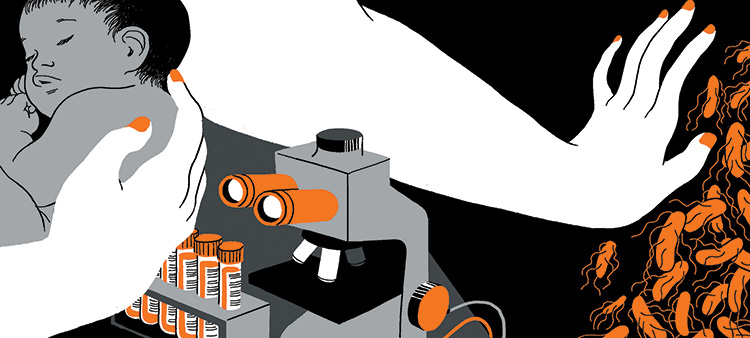Patricia Pavlinac ’05 is helping to find solutions to aid children in Africa and South Asia fight a life-threatening illness.
When Patricia Pavlinac ’05 pops into the Zoom window, she has to fix her username, which still appears as “Shigella” from an earlier meeting. Nobody wants this bacterium as a guest. But Pavlinac — an assistant professor in the University of Washington’s Global Center for Integrated Health of Women, Adolescents, and Children — has Shigella on her mind all the time.
Globally, this infection is the second-leading cause of diarrhea. It’s estimated to kill more than 200,000 people each year, including more than 60,000 children under the age of 5.
A parent in the United States doesn’t usually have to worry that their child may die of diarrhea. But in many parts of sub-Saharan Africa or South Asia, “That is a very real risk,” Pavlinac says. That’s why she has her focus on Shigella and other major causes of diarrheal illness. If the world paid more attention to these threats, it could make a huge difference in the lives of children and their families.
Pavlinac first became interested in infectious diseases, and especially in disparities among the treatments that patients can access in different parts of the world, when she joined the Peace Corps after graduating from Colgate. In low- and middle-income countries, she says, a lack of clean water and sanitation can mean there are more dangerous microbes around. Underlying conditions such as malnutrition or HIV may make young kids more vulnerable when they encounter those microbes.
The infection itself isn’t the only dangerous thing about Shigella. “This is just one of those bugs that puts itself in your intestines and wreaks all sorts of havoc,” Pavlinac explains. It can cause dysentery, or bloody diarrhea. The damage it does to the gut can leave children more prone to malnutrition afterward.
“Many of us naively assume diarrheal disease is really simple,” Pavlinac says. Doctors and scientists understand the basics of what causes diarrhea and how to treat kids who get dehydrated. However, she says, that understanding has “ginormous gaps.”
For example, hospitals in low- and middle-income countries may not have the resources to test a child who shows up with serious diarrhea and figure out what virus, bacterium, or parasite is causing it. “Doctors are going blindly in terms of how to treat the underlying cause of diarrhea,” Pavlinac says, and are cautious about providing antibiotics because they increase the risk of antibiotic resistance.
That’s why some scientists are working to develop rapid tests for diarrheal illnesses, Pavlinac says. In her own research, she’s studying whether identifying which kids have Shigella, then treating those kids judiciously with antibiotics, can improve their chances.
“We would never advocate for willy-nilly antibiotic use,” Pavlinac says. But early results suggest that targeting the drugs to high-risk children with Shigella infections improves their outlook.
To prevent those infections from happening in the first place, Pavlinac is also working with research teams around the world to prepare for clinical trials of Shigella vaccines that other research groups are developing now. Although Shigella diarrhea is not a new disease, Pavlinac says momentum has built in recent years to finally develop Shigella vaccines for children.
Even more recently, the COVID-19 pandemic has made the general public more familiar with the science of infectious diseases. “That’s been really nice,” Pavlinac says. “Before, when I would say I’m an epidemiologist, people would say, ‘Oh, you study the epidermis!’” She also thinks people recognize now that infectious diseases don’t just affect people who get sick — they can reverberate through entire world economies.
Pavlinac’s own work was recognized last year by the Washington Global Health Alliance. In its first ever Global Health Impact Awards, the group granted Pavlinac the Rising Star Award, for an individual age 40 or younger who’s making a major difference in global health.
Pavlinac says it “feels critical” to use her voice to highlight the importance of this research area, as well as the often-unrecognized work of her collaborators in parts of the world where Shigella takes the greatest toll. “The uplifting part is what a gift it is that we can be, hopefully, one small part of the solution,” she says.

